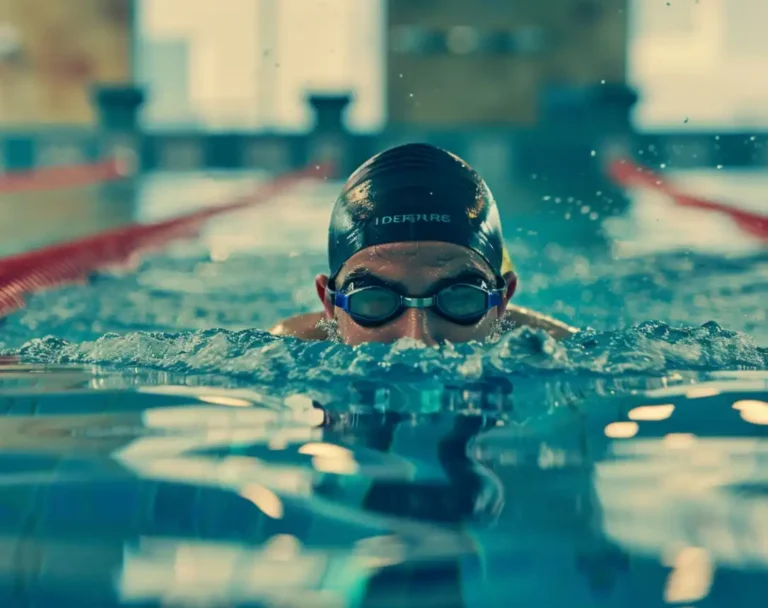Embark on a buoyant journey to master the art of floating with our guide on swimming how to float. Floating is the foundation of swimming, offering both a starting point for beginners and a critical survival skill. It’s about finding balance and relaxation in the water, allowing your body to become one with its natural buoyancy.
Whether you’re learning to swim or enhancing your aquatic abilities, understanding the principles of floating can transform your relationship with water. Let’s dive into the serene world of floating, where confidence and calmness meet.
Basics of Buoyancy
When I first dipped into the world of swimming, the idea of floating seamlessly atop the water seemed almost magical. Yet, it’s all about understanding buoyancy. Buoyancy is the force that enables us to float in water. It’s not just for boats and life jackets—I too can harness this force with some basic know-how!
Here’s a quick breakdown:
- Density: It’s a battle between my body’s density and that of water. If I am less dense, I float; more dense, and I might sink. Since the human body is roughly 60% water, we’re not far off density-wise.
- Body Composition: My body composition is key; fat is less dense than water, while muscle is denser. A higher body fat percentage can make floating easier.
- Breathing Technique: Taking a deep breath fills my lungs with air, increasing my buoyancy since air is much less dense than water.
To master buoyancy, consider:
- Relax: Tension makes my muscles denser. I keep calm and spread out to increase my surface area.
- Arch My Back: By arching my back slightly and keeping my head up, I push my stomach up, making it easier to float.
- Leg Position: I keep my legs horizontal and try not to let them drop, as this can make me sink.
Mastering buoyancy is all about balance and understanding my relationship with the water. With practice, I find myself triumphing over gravity, floating effortlessly!
Getting Comfortable in Water
I’m thrilled to guide you through this fundamental step in your swimming journey: getting comfy in the liquid embrace of a pool! Whether you aim to float effortlessly or just want to savor the delight of being buoyant, grasping the basics will transform your experience.
Overcoming Fear
Firstly, conquering fear is essential. Acknowledge that it’s okay to feel hesitant. Many adults face this when learning to swim, but remember, with each small step, you get closer to being fearless. Always start in the shallow end, where you can easily stand and grab the pool wall for support.
Understanding Your Body
A crucial fact: every body can float! Weight or body shape doesn’t decide if you’ll sink. It’s all about your technique and how well you can relax. Keep in mind, your lungs are like natural floatation devices; increasing your lung capacity can make floating easier.
Safety First
Safety always takes precedence—never swim alone. Ensure a lifeguard is on duty or swim with a buddy. If an instructor is within reach, that’s even better as they can save your life in an emergency and provide essential swimming lessons.
Breathing Techniques
Let’s talk breathing: take a deep breath through your nose, fill your lungs with precious oxygen, and then exhale slowly. Mastering this will help you keep afloat and remain calm on the surface of the water.
Entering the Water
Finally, entering the water should be gradual. Use a pool noodle or hold onto the pool wall if you need extra support. Each moment you spend getting accustomed to the water’s feel will pay off immensely as you become more comfortable and start to truly enjoy floating.
Mastering the Float
Mastering the art of floating in water is like finding the perfect balance between relaxation and technique. It’s the first step toward swimming proficiency, and I’m excited to share specific methods that will keep you buoyant and confident.
Back Floating Basics
When back floating, it’s all about positioning. Place your head back gently, ensuring the water line sits just above your ears, allowing your ears to be submerged. This will keep your face out of the water. Tilt your chin slightly upward to help keep water from splashing over your face. Keep your stomach up and hips pushed toward the surface; this creates a natural buoyancy.
Your arms and legs play a critical role; spread them slightly to increase stability. Imagine your body forming a gentle “T” shape in the water. Practice this in a calm pool, where unexpected waves won’t disrupt your balance.
Front Floating Steps
Front floating begins with a deep breath in to fill your lungs with air, adding to your natural buoyancy. Extend your arms forward with your palms down, and place your head between your arms, face down in the water. Your head should align with your spine, and remember to keep your body as straight as possible.
Pushing your chest slightly downward will help keep your hips up, so you’re floating flat like a plank. However, keep your muscles relaxed to avoid sinking. You’ll have to practice holding your breath in this position, occasionally coming up for air when necessary.
Perfecting the Starfish
The starfish pose is a fun and effective way to float. It enhances stability by spreading your limbs and distributing your weight. To get into position, lie on your back and spread your arms and legs into an ‘X’ shape. Keep your limbs extended but not rigid.
The wider spread of limbs acts as stabilizers, much like a sea star, hence the name. The key is in the gentle extension; don’t strain or stiffen, as it alters your body’s buoyancy. Frequent practice will help you maintain a comfortable starfish stance that maximizes surface area and keeps you afloat effortlessly.
Floating Drills and Practice
I’ve discovered that mastering the art of floating in water is both exhilarating and fundamental for any swimmer. By strongly engaging our core muscles and finding our balance, we create a stable base that improves our swimming efficiency. Let’s dive into some targeted drills and practices.
Kickboard Drills
Purpose: To build leg strength and promote stability.
Kicking Glide:
- Hold the kickboard out front.
- Push off the wall, face down, and flutter kick to maintain momentum.
Back Float Kick:
- Lie on your back with the kickboard resting on your thighs.
- Kick gently to keep afloat, ensuring continuous breathing.
Noodle Exercises
Objective: Enhance core strength and improve balance.
- Sit on the pool noodle like a bike.
- Use your arms and legs to maintain an upright position without tipping.
- Place the noodle under your armpits.
- Practice mirror floating to observe your stability.
Partner Work
Goal: Receive real-time feedback for quick improvement.
Assisted Back Float:
- Your partner provides slight support under your back.
- Attempt to balance without their help gradually.
Rotation Practice:
- With goggles on, your partner observes and guides your rotation from front to back float.
- Key focus: smooth transitions with no sudden movements.
By persistently practicing these drills with essential gear like kickboards and pool noodles, I’ve noticed a significant improvement in my stability and buoyancy in the water. Consistent feedback from a swim coach or a partner ensures I keep bettering my floating technique.
From Floating to Swimming
When I first learned that mastering floating was just the beginning, I felt a surge of excitement. Moving from effortlessly floating to confidently swimming was a transformative experience. Now, I’ll share how you can gracefully transition from a state of buoyancy to a symphony of strokes.
Transition to Strokes
Once I had floating down, I began to introduce my arms and legs to basic swimming strokes. Breaststroke was my starting point—with its simple gliding motion, it seemed the most natural following floating. It’s vital to ensure a smooth synchrony between the arms and legs. My arms would sweep in a circular motion, beginning at the chest and ending at the hip, while my legs performed a frog kick.
Integrating Movements
Gradually, I built upon this foundation, paying attention to how my swimming technique influenced my ability to move through the water. For the butterfly stroke, I focused on the undulating, dolphin-like movements of my body, ensuring my arms and legs worked in harmony. My arms would pull in a keyhole pattern, with my legs executing a powerful dolphin kick. This synchronized movement between my arms and legs helped me glide through the water with less effort and more speed.
Developing a Routine
Creating a swimming routine became essential. I stuck to a practice schedule that defined my swimming sessions, with a specific frequency and duration tailored to my goals. I committed to hitting the pool three times a week, never swimming for less than 30 minutes. As I became more proficient, the time spent in the water naturally increased, and the exhilaration of seeing my progress kept me coming back for more.
Additional Resources and Tools
I’ve discovered the power of knowing the right resources and tools when learning to swim and especially to float. With the right flotation devices and guidance, you can progress quickly and build your confidence in both pool and open waters. I’m excited to share what I’ve found to be the most helpful!
Selecting Flotation Devices
When first starting out, the right flotation device can be a game-changer. It’s all about safety and building that crucial water confidence. Pool noodles and flotation aids like armbands or swim vests are perfect for beginners. Check the below table for a quick guide:
| Flotation Device | Use Case | Ideal For |
|---|---|---|
| Pool Noodles | Flexible, fun aids | Enhancing stability |
| Swim Vests | Fixed buoyancy | Non-swimmers or beginners |
| Arm Bands | Adjustable buoyancy | Learning arm movements |
Choose devices certified by reputable safety standards to ensure you’re in good hands.
Taking Swimming Lessons
Getting professional swim lessons from a certified instructor propels your swimming skills forward. Lessons ensure you learn the correct techniques and reduces the risk of developing bad habits. Make sure your instructor is qualified and well-reviewed. Swim lessons can vary, so opt for either private or group settings depending on your comfort level.
Swimming in Open Waters
Swimming in open waters is a thrilling step-up from the pool. The presence of currents in both saltwater and freshwater environments makes it challenging. Always swim in designated areas supervised by a lifeguard. Increased safety measures and the knowledge of open waters dynamics are non-negotiable. Remember, natural water bodies are unpredictable, so never overestimate your abilities and always have a swimming buddy.
Understanding the Physics
Have you ever wondered how I can lie on the water without sinking? It’s not magic—it’s physics! The concept of buoyancy plays a crucial role. My body, much like any object, will float if the water it displaces weighs more than my body itself. Essentially, it’s a battle between opposing forces: gravity pulling me down and the buoyant force pushing me up.
Let’s dig into the specifics. Water has a density of about 1 gram per cubic centimeter. I float better when my average density is less than that. Since my body is composed mostly of water, with a similar density, what gives? Well, it’s the air in my lungs and my body’s composition that can tip the scales. By taking a deep breath, I increase my body’s volume without a significant change in mass, thus reducing my overall density.
Here is a simple breakdown:
- Buoyant Force: Upward force exerted by the fluid, which keeps me afloat.
- Gravity: Downward force due to my weight, trying to pull me underwater.
Here’s the kicker: different body types float differently. Fat tissue, having a lower density than water, aids buoyancy, while muscle and bone, denser than water, can make it trickier. Knowing this, I can adjust my swimming technique or my body’s position to optimize flotation. Isn’t that exciting?
Armed with this knowledge, anyone can learn to harness the laws of physics for a smooth and serene floating experience. Just remember: it’s all about understanding and working with the buoyant force to stay afloat.
Advanced Floating Techniques
Ever jumped into a pool and admired how some swimmers seem to be part of the water? Well, I’ve been there too! Mastering advanced floating techniques can make you glide through the water with ease, almost like a human boat! First up is perfecting your freestyle. This stroke isn’t just about thrashing through the water; it’s about grace and balance.
When I focus on my freestyle, my belly button becomes my secret compass. By keeping my core engaged and belly button pulled slightly inward, I improve my stability and buoyancy. It feels like I’m lying on an invisible water bed, completely at peace with the waves.
Adding a slow and controlled flutter kick helps as well. Imagine your legs as long, powerful fins, propelling you without splashing. They maintain my momentum, allowing my body to hover just atop the surface. Now, let’s talk about the glide. I achieve this by stretching out my arms in front, cutting through the water like a sleek seal.
Remember, we’re focusing on sophistication over speed here. Every motion is deliberate, every breath is measured. Rotate your body smoothly from side to side with each stroke, allowing the water to move around you, not against you. It’s an exhilarating dance with the waves, and I promise, it’s a feeling like no other!
Health Benefits of Swimming
I’ve discovered that swimming isn’t just a leisure activity—it’s a full-body workout that offers a myriad of health benefits! When I effortlessly float and glide through the water, it feels like a dance. Little did I know, each stroke was enhancing my health in ways beyond imagination.
Firstly, swimming is a fantastic way to boost heart health. The constant movement challenges the heart, making it stronger and more efficient at pumping blood. It’s exciting how this fun activity can be a formidable ally against heart disease.
Abdominal Muscles: Each kick and stroke engage my abdominal muscles, contributing to a firmer, toned midsection. Who knew that pursuing leisure could also chisel my abs?
- Boosts Cardiovascular Health
- Improves Muscle Tone
- Increases Endurance
Swimming is also a low-impact exercise, which means it’s easy on my joints while still providing a challenging workout. It’s amazing how I can push myself hard in the pool without worrying about the wear and tear that comes from high-impact activities. Swimming has truly become a centerpiece in my quest for a healthy and vibrant lifestyle!
Recognizing Individual Progress
As I embarked on my swimming journey, I quickly learned the importance of setting personal benchmarks to monitor my progress. It was thrilling to see how each kick and stroke got me closer to my first milestone. Reflecting on my achievements, I realized how integral it was to recognize the strides I made.
I began by documenting my starting point. Just staying afloat was once a challenge, but now, it’s a piece of cake. My swimming log includes dates, techniques practiced, and how I felt after each session. Tracking my stamina and breath control improvements gave me tangible evidence of my growth.
Milestones like my first unassisted lap felt monumental. Celebrating these moments created a snapshot of my progress. Here’s a simple way I kept track:
- Week 1: Floated without support.
- Week 4: Completed a 10-meter swim with proper technique.
- Week 8: Achieved a new personal best time.
These benchmarks served as my personal cheerleaders, urging me to dive into each challenge with renewed eagerness. They demonstrated that my efforts were shaping me into a more proficient swimmer. Every splash I make now resonates with the knowledge that I am one stroke closer to the swimmer I aspire to be.
FAQ – Frequently Asked Questions
Why is floating important in swimming?
Floating is a fundamental skill that promotes water safety, helps swimmers conserve energy, and builds confidence in the water.
What are the key techniques for floating?
Relax your body, take deep breaths, gently lay back, and distribute your weight evenly to achieve natural buoyancy.
Can everyone learn to float?
Yes, with practice and proper technique, everyone can learn to float, regardless of body type or swimming level.
Thank you for joining us to discover the calming art of floating in swimming. Your journey towards buoyancy and water confidence is inspiring. Share your floating experiences and tips in the comments below or connect with us on social media platforms like Instagram and Pinterest. Let’s float towards a more confident swim together!






